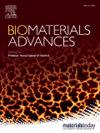Construction and biocompatibility of penetrating corneal transplant substitute with cross-linked acellular porcine cornea and biopolymer polyurethane
IF 5.5
2区 医学
Q2 MATERIALS SCIENCE, BIOMATERIALS
Materials Science & Engineering C-Materials for Biological Applications
Pub Date : 2025-01-27
DOI:10.1016/j.bioadv.2025.214201
引用次数: 0
Abstract
In this study, acellular porcine cornea (APC) was composited with biopolymer polyurethane (PU), in which Polyethylene glycol (PEG) served as porogen, to fabricate a breathable and impermeable barrier and maintain the transparency of APC. To improve the effect of decellularization on the collagen fibrolamella of the APC, structural regularity and stability as well as postoperative corneal edema and melting, crosslinking was taken as an effective way to improve the mechanical properties and anti-enzymatic hydrolysis of APC. Chemical cross-linking in different agents, crosslink concentrations, and reaction times were conducted. The transparency, elastic modulus, oxygen permeability, crosslinking degree, and expansion thickness were examined. Furthermore, the immunogenicity, cytocompatibility, and histocompatibility of the cross-linked APC-PU composite under the optimal crosslinking parameters (GP-0.2 %-3.0, EDC-1.0 %-1.0, GD-0.8 %-0.3) were analyzed. The results showed that the GD-0.8 %-0.3 samples demonstrated cytotoxicity and significant neovascularization during subcutaneous experiments. Moreover, a proliferation membrane was formed on the PU surface in the orthotopic transplantation, suggesting immune rejection. The GP-0.2 %-3.0 group exhibited pronounced edema and delamination in the 4th week, indicating inadequate permeability and incomplete fiber cross-linking. However, the EDC-1.0 %-1.0 group promoted cell adhesion and proliferation, while maintaining graft integrity without degradation upon subcutaneous implantation. No corneal swelling or degradation was observed within 4 weeks post-transplantation. Cross-linking of EDC/NHS is an effective method for fabricating the ideal and functional APC-PU composite for penetrating keratoplasty.
求助全文
约1分钟内获得全文
求助全文
来源期刊
CiteScore
17.80
自引率
0.00%
发文量
501
审稿时长
27 days
期刊介绍:
Biomaterials Advances, previously known as Materials Science and Engineering: C-Materials for Biological Applications (P-ISSN: 0928-4931, E-ISSN: 1873-0191). Includes topics at the interface of the biomedical sciences and materials engineering. These topics include:
• Bioinspired and biomimetic materials for medical applications
• Materials of biological origin for medical applications
• Materials for "active" medical applications
• Self-assembling and self-healing materials for medical applications
• "Smart" (i.e., stimulus-response) materials for medical applications
• Ceramic, metallic, polymeric, and composite materials for medical applications
• Materials for in vivo sensing
• Materials for in vivo imaging
• Materials for delivery of pharmacologic agents and vaccines
• Novel approaches for characterizing and modeling materials for medical applications
Manuscripts on biological topics without a materials science component, or manuscripts on materials science without biological applications, will not be considered for publication in Materials Science and Engineering C. New submissions are first assessed for language, scope and originality (plagiarism check) and can be desk rejected before review if they need English language improvements, are out of scope or present excessive duplication with published sources.
Biomaterials Advances sits within Elsevier''s biomaterials science portfolio alongside Biomaterials, Materials Today Bio and Biomaterials and Biosystems. As part of the broader Materials Today family, Biomaterials Advances offers authors rigorous peer review, rapid decisions, and high visibility. We look forward to receiving your submissions!

 求助内容:
求助内容: 应助结果提醒方式:
应助结果提醒方式:


